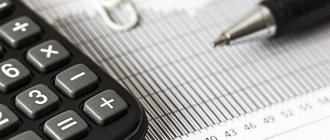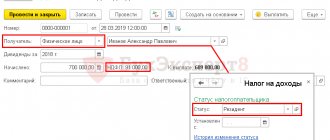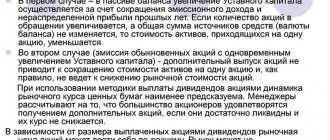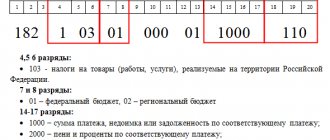Tax rate
After January 1, 2015, personal income tax on dividends must be deducted in the amount of 13 percent (before January 1, 2015 it was less - only 9%). Moreover, regardless of the period of their distribution. But in practice, one can also encounter special cases of calculating and paying income tax on such income.
Based on paragraph 1 of Article 224 of the Tax Code of the Russian Federation, personal income tax on dividends in 2018 for those persons who stayed in the Russian Federation at the time of payment for at least 183 days during the year - that is, for residents - is 13%. Although, as for non-residents, the tax for this category is 15%.
The company determines the tax status of its member or shareholder at the time of any dividend payment. That is, a person can become a non-resident or still a resident of the Russian Federation within a year. Based on the results of the 12-month period, the company determines the exact tax status of the dividend recipient and determines the appropriate tax rate for it. Keep in mind: if a person’s status changes, personal income tax is recalculated as for the full tax period.
Personal income tax rate on dividends
Until 2015, the tax on dividends had to be withheld at a rate of 9%. Since the beginning of 2015, the personal income tax rate has increased, regardless of the period in which payments to the founders are distributed. The tax rate on dividends depends on the status of the recipient of the founders' payments. If he is a resident of the Russian Federation, then a rate of 13% should be applied; if the recipient is not a resident, then the rate is 15%. The exception applies only to double taxation avoidance agreements concluded with foreign countries. It is necessary to determine what status the recipient of the founding payment belongs to at the time of its distribution.
Important! For residents of the Russian Federation, the personal income tax rate on dividends is 13%, for non-residents – 15%.
To tax or not
From any income of an individual, including dividends, a percentage of the amount issued must be transferred to the treasury.
The date of transfer of dividend income is the day of their payment, regardless of how they were received - through the organization's cash desk, from its current account, or the money was issued in cash. That is why tax on dividends must be withheld on the day they are transferred.
Some people are concerned about the question of whether dividends are subject to personal income tax if they are received in kind. So: if they are issued to an individual in any form, the tax rate is 13%. Therefore, the tax occurs regardless of how such income from participation in the business was received.
Where to pay
Personal income tax must be paid at the time of transfer of dividends. But there are cases when a company is registered with the tax inspectorate of one city, and transfers a share of the profit to its founder in a completely different area. That is, at his place of residence. In this situation, the question arises: where to pay income tax on dividends?
It is important to know that payment of tax does not depend on where the recipient of a portion of the profit from the business lives or is registered. The company must necessarily transfer personal income tax on dividends received by the person to the place of the inspection where it is registered. This is done on the day of transfer of dividends or on the next day on the basis of paragraph 6 of Article 226 of the Tax Code of the Russian Federation.
Income tax on dividends is transferred to the usual for personal income tax KBK - 182 1 0100 110.
Deadline for transferring personal income tax on dividends in 2021
The period for paying personal income tax on founder's payments depends on the legal form of the organization making the payments.
For LLCs, the following rule has been established for determining the deadline for paying personal income tax: the tax must be transferred no later than the day following the day of payment of dividends. It does not matter where the money was issued from, from the cash register or transferred to the founder’s card. Dividends, by the way, can even be transferred to a third party indicated by the founder.
An organization must transfer personal income tax at the place of its registration, regardless of where the recipient of the dividends is registered.
Important! The BCC for paying personal income tax on dividends is the same as for paying income tax on other income. KBK 182 1 0100 110.
Let's look at an example:
Let's assume that the organization paid dividends to one of the participants on April 10, 2021. Personal income tax from this payment must be transferred on the same day or the next, that is, April 11, 2021. If the payment occurs on Friday, April 13, 2021, then personal income tax must be transferred no later than April 16, 2021. This rule applies to LLCs. For JSC, the rules are different. Tax on dividends on shares of a Russian company is paid to the budget within up to 1 month from the date of payment.
Let’s summarize the deadlines for paying personal income tax on dividends in 2021 into a table (click to expand)
| Entity | Deadline for paying personal income tax on dividends |
| OOO | The deadline for paying personal income tax is the next day after the payment of dividends |
| JSC | Personal income tax is paid within 1 month from the date of payment of dividends |
Important! If the deadline for paying personal income tax on dividends falls on a weekend or holiday, it is postponed to the next working day.
Income calculation
In order to calculate a resident’s personal income tax, you need to use the general tax rate that is relevant on the day the income is received. If this is 2021, then dividends in the 2-NDFL certificate are calculated at a rate of 13%.
There are cases when a shareholder/business participant was unable to receive his money as a result of errors in the details, so he has no dividend income in such a situation.
If the company received its dividends from a business in another organization, then the formula from clause 5 of Art. 275 Tax Code of the Russian Federation.
In this case, the share of dividends of an individual is first determined, for which the amount of payment to his account is divided by all accrued dividends. Next, you need to calculate the difference between the dividends that a person received last year, the current period and the sum of all distributed dividends. That is, the first indicator is multiplied by the second and by the percentage tax rate.
Income tax for non-residents of the Russian Federation: when other rates apply
According to paragraph 3 of Art.
224 of the Tax Code of the Russian Federation, the tax rate on income of non-residents is 30%. We list all possible cases when the personal income tax rate for non-residents will be different from 30%:
- The tax rate is 15% if any individuals who are not recognized as residents of the Russian Federation received income in the form of dividends as participants in Russian companies (clause 3 of Article 224 of the Tax Code of the Russian Federation).
- The tax rate is 13% if income is received from labor activities in the Russian Federation by the following categories of non-residents:
- foreigners working under a patent (clause 3 of article 224, article 227.1 of the Tax Code of the Russian Federation);
- foreigners who are highly qualified specialists (clause 3 of article 224 of the Tax Code of the Russian Federation);
Not all income of highly skilled foreigners is taxed at 13%. Read more about this in the material “At what personal income tax rate is the income of a highly qualified foreign employee taxed?”
- compatriots who previously worked abroad and are now participants in the state program for their voluntary resettlement to Russia, as well as members of their families (clause 3 of Article 224 of the Tax Code of the Russian Federation);
- citizens of foreign countries or stateless, if they are recognized as refugees or have been granted temporary asylum in the Russian Federation (clause 3 of Article 224 of the Tax Code of the Russian Federation);
- crew members of those ships that are assigned to the ports of the Russian Federation and sail under its flags (clause 3 of Article 224 of the Tax Code of the Russian Federation);
- foreigners if their countries are members of the Eurasian Economic Union (Article 73 of the Treaty on the EAEU dated May 29, 2014, which entered into force on January 1, 2015). An important nuance for this category of persons is here.
ConsultantPlus explains: If the employee is a resident of another country, be sure to study the double taxation agreement concluded between this country and the Russian Federation. For example, a foreign citizen grants a Russian organization, for a fee, the right to use his literary work on the territory of the Russian Federation. The author is a tax resident of the Republic of Cyprus. The author is not a tax resident of the Russian Federation. Remuneration for the right to use a work is income from a source in the Russian Federation and, according to the rules of the Tax Code of the Russian Federation, should be subject to personal income tax (clause 3, clause 1, article 208 of the Tax Code of the Russian Federation, clause 2, article 209 of the Tax Code of the Russian Federation). However... Read the continuation of the example, having received trial access to the K+ system. It's free.
Separately, it should be noted that the same principle applies to non-residents as to residents: income that is exempt from taxation for domestic taxpayers does not need to be subject to personal income tax. More details about this can be found in the letter of the Ministry of Finance of Russia dated October 29, 2012 No. 03-04-05/4-1226.
ConsultantPlus experts explained who is a non-resident for the purpose of calculating personal income tax. Get free trial access to the system and move on to the Ready-made solution.
For information on how residency is confirmed, read the article “A service has been launched to confirm the status of a tax resident of the Russian Federation .
Payment nuances
Let's say a company transferred dividends on shares to its participants and paid personal income tax. However, the money was returned due to changes in shareholder details. Then, in fact, she is forced to transfer the amount of income to them a second time. This means that you do not need to remit the tax.
If the shareholder did not receive money as a result of errors with details, then his actual income is missing. Personal income tax, which was previously transferred to the budget, has the status of an overpayment that must be returned. If there was a subsequent transfer of dividends to him, then the tax is withheld and paid again. But the position of the Ministry of Finance is that the company may not return the overpayment, since it can be counted during the second call, without even drawing up a special statement.
Tax deferment
An organization has the right to defer payment of personal income tax on dividends to the founder if it has a counterclaim against this person. For example, if the founder does not repay the debt or has not paid for the goods. Therefore, all counter debts must be offset. And if the founder’s debt is greater than or equal to the amount of dividends, then the company has the right not to transfer funds from dividends to him. It is as if she takes a deferment from paying personal income tax on such income.
The fact that the founder received income from which it was not possible to pay dividend tax must be reported to the tax office and to him himself no later than March 1 of the next year. Next, the participant or shareholder independently submits an income tax return, according to which he will pay the tax no later than July 15 of the following year.
Tax on dividends of legal entities
When paying income to legal entity participants, NNP .
The rate of this payment depends on the status of the legal entity receiving the funds: a foreign company or not and its share in the authorized capital of the organization that paid the dividends.
Table No. 2. NPT rate when paying income to participants-legal entities
| Legal entity status | Tax rate |
| Russian organization | 13% |
| A Russian organization that has more than 50% of the share in the authorized capital of the company that paid the income* | 0% |
| Foreign organization | 15% (or other rate established by international agreement) |
* The period of ownership of the specified share in the authorized capital of the company paying dividends must not be less than 365 days at the time of the decision to pay funds to the participant
The NNP must be transferred no later than the day the funds are transferred to the participant-legal entity.
Table No. 3. BCC for payment of dividends to a legal entity participant
| Recipient of funds | KBK |
| Russian company | 182 1 0100 110 |
| Foreign company | 182 1 0100 110 |
Funds paid to participants must be reflected in the tax return declaration (Sheet 03).
The deadline for submitting these reports depends on the procedure for paying advance payments under the NNP.
How to reflect 2-NDFL in the certificate
In addition to dividends, the income certificate includes all information about an individual’s income for the past year and tax amounts for a given period. How to reflect dividends on the income statement?
These data are reflected according to the established code of this income 1010. It was also used previously.
EXAMPLE
At the end of 2021, it was decided to pay dividends. However, until January 1, 2021, the corresponding amounts were not credited to the recipients’ accounts.
In this situation, the 2-NDFL certificate for 2021 will be without dividends. Income from them must be shown in the certificate for the period when the dividends were actually paid. That is already for 2018.
In addition, the total amounts of dividends paid and personal income tax taken from them must be reflected in the quarterly calculation in form 6-NDFL.
For more information about this, see “Dividends in 6-NDFL: filling out a sample calculation.”
Read also
17.06.2019
Payment of dividends to non-residents: step-by-step instructions
A citizen with the status of a non-resident of the Russian Federation can be a participant or founder of an organization. When paying dividends to a non-resident of the Russian Federation, an accountant should be guided by the general principles of calculation and accrual. When paid, non-resident dividends are subject to personal income tax at a rate of 15%.
How to calculate and pay dividends to a non-resident and what documents are required for this - we will look at the step-by-step instructions below:
Step #1 – Profit calculation
At the first stage, it is necessary to calculate the organization's profit for distribution by determining the difference between assets and liabilities. Let us remind you that only the net profit of the enterprise is subject to distribution, that is, after payment of all taxes and fees.
Step #2 – Deciding on Profit Distribution
The basis for the distribution of net profit through the payment of dividends to participants (shareholders) is the corresponding decision of the board of the organization. As a rule, this decision is made at the end of the calendar year on the basis of annual financial statements. At the same time, the organization has the legislative right to distribute profits as dividends quarterly, but not more often.
The decision is made in writing signed by all participants (shareholders), as well as the head of the board. Profit can be used to pay dividends either in full or in part. For example, by decision of the board, 70% of the profit can be used to pay dividends, the balance (30%) can be invested in business development by purchasing new equipment and expanding the production line.
The law provides for the following cases in which dividends are not paid:
| No. | Conditions | Description |
| 1 | Debt of participants on the authorized capital | Profit can be used to pay dividends, provided that all participants (shareholders) have repaid the debt of their share in the authorized capital. If at least one participant has a debt (in any amount and type), dividends are not paid. |
| 2 | Signs of bankruptcy of an organization | Payment of dividends is prohibited in relation to organizations with signs of bankruptcy (according to Article 3 of Law No. 127-FZ of October 26, 2002). Also, dividends are not paid if such payment could lead to bankruptcy of the enterprise. |
| 3 | Authorized capital exceeds net assets | If the size of net assets (line 300 Assets + line 640 Deferred income - lines 590 and 690 Liabilities) is less than the amount of the authorized capital, dividends are not paid to shareholders and participants. |
Step #3 – Calculation of dividends for a non-resident
The amount of dividends for a non-resident is calculated in the general manner - based on the share of participation in the authorized capital. An enterprise does not have the right to distribute profits to pay dividends only in relation to some participants (for example, founders), and for other participants to form a debt on dividends.
Payment is made in strict accordance with the share of participation of each shareholder.
Let's look at an example . Based on the decision of the board of Faza Plus LLC dated January 17, 2021, 50% of the net profit received by the organization at the end of 2021 is used to pay dividends.
The net profit of Faza Plus LLC amounted to 840,320 rubles, so the amount of 420,160 rubles will be allocated as dividends.
The participants of Faza Plus LLC are:
- Petukhov – share in the authorized capital 42%;
- Serpukhov – share in the authorized capital 48%;
- Molotov – share in the authorized capital of 10%.
In 2021, Molotov (citizen of the Russian Federation) was on the territory of the Russian Federation for a total of 110 days, the rest of the time he was in the Canary Islands. In this regard, Molotov is recognized as a non-resident of the Russian Federation.
The calculation of dividends for each participant to be accrued is carried out in the following order:
| Member of LLC | Petukhov | Serpukhov | Molotov (non-resident) |
| Share in the authorized capital | 42% | 48% | 10% |
| Calculation of dividends to be accrued | 420.160 rub. * 42% = 176,467.20 rub. | 420.160 rub. * 48% = 201,676.80 rub. | 420.160 rub. * 10% = 42.016 rub. |
As you can see, the residence of an LLC participant does not affect the procedure for calculating dividends for accrual.








